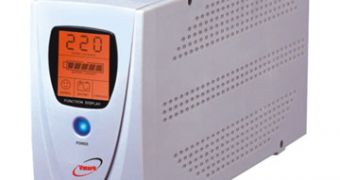You're working late on your computer one night and all of a sudden the power goes off. All your unsaved work goes to waste and you start cursing the electricity company as you have to do everything all over again. Don't you wish you had a UPS? A UPS, or an uninterruptible power source, is an electronic device able to maintain an alternative continuous electric power supply to electronic equipment connected to it when the primary power sources become unavailable.
Unlike auxiliary power, a UPS provides instant protection of the powered equipment but can output energy only for small amounts of time, usually up to several tens of minutes, allowing the electronic device connected to it to shutdown properly, which could otherwise result in extensive physical damage. Although its use can extend to a virtually unlimited list of applications, in the past years the UPS became even more popular as a means of protecting computers and telecommunication equipment, thus preventing serious hardware damage and data loss.
A typical UPS for computers has four basic protection roles, being able to cope with power surges, voltage shortage, complete power failure and wide variations in the electric current frequency. There are three types of UPS systems, depending on how the electric power is being stored and relayed to the electronic device connected to them: the off-line UPS, also known as standby UPS, the line-interactive or continuous UPS and the on-line uninterruptible power supply, often called double conversion supply.
The first two types are currently amongst the most common devices used to safeguard computers from unusual electric currents.
Typical off-line UPS systems redirect the whole electric current received from the outlet to the computer and only switch to providing power from the battery when a problem is detected in the utility power. Performing this action usually takes several milliseconds, during which time the power inverter starts supplying electric current from the battery to the computer.
Line-interactive uninterruptible power supplies on the other hand, always relay electric energy through the battery to the computer, meaning that the battery of the UPS is continuously charging and the lag related to coupling the inverter is basically close to zero. Due to these characteristics, continuous UPS systems tend to be somehow more expensive than standby supplies.
The last type, and the most expensive of the three UPS designs, the online supply, combines the two basic technologies used in the fabrication of the previously described UPS models, having rectifiers and inverter systems working all the time. As is the case with line-interactive UPS devices, the power transfer is made instantly as an outage occurs, the rectifier simply being turned off while the inverter draws power from the battery. As utility power is again established, the rectifier starts relaying most of the power to the connected devices, while the inverter resumes its activity, recharging the battery.

 14 DAY TRIAL //
14 DAY TRIAL //